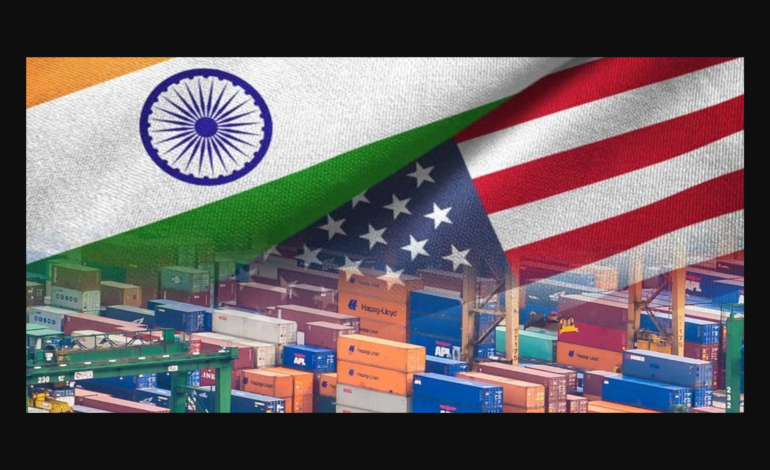
Navigating stormy trade waters and shifting alliances in Indo-U.S. relations
By: Dr Avi Verma
As we embark on 2025, the once steady Indo-U.S. partnership finds itself at a critical crossroads. A combination of geopolitical shifts, economic turbulence, and evolving global alliances has brought the relationship between the two democracies to a pivotal moment. On one hand, there is an undeniable convergence of interests in defense, technology, and countering China’s rising influence in the Indo-Pacific. On the other, mounting tensions over trade practices, tariffs, and India’s growing engagement with the Indo-China-Russia bloc are testing the foundations of this alliance.
The Unprecedented Impact of U.S. Tariffs on India
In the most immediate and visible strain, the U.S. has imposed unprecedented tariffs on Indian imports, raising duties to a staggering 50%. This move, driven by President Trump’s concerns over India’s trade deficit and its continued imports of Russian oil amidst the Ukraine crisis, has sent shockwaves through the economic relationship. Tariffs targeting labor-intensive sectors like apparel, gems, and furniture are among the steepest levies ever enacted, putting Indian exporters at a significant disadvantage and threatening decades of cooperation.
Projections estimate that India’s export revenues to the U.S. could fall by as much as $55–60 billion by 2026, pushing the nation’s growth trajectory down by at least 0.5%. This, as analysts warn, could push many small exporters to the brink of collapse. The 50% tariff—a combination of punitive measures over oil purchases and defense relations—has triggered immediate concerns about the broader economic fallout, not only in trade but in mutual strategic cooperation.
A Strategic Pivot: The Indo-China-Russia Alliance and Its Impact
Beyond the trade front, another factor is playing a decisive role in reshaping Indo-U.S. relations: India’s growing involvement in the Indo-China-Russia BRICS alliance. This multi-dimensional alignment is reshaping the strategic calculus, especially as the world increasingly embraces a multipolar order. India’s deepening ties with Russia in defense and energy, coupled with its cautious approach to China, have raised concerns in Washington.
The U.S. sees China as its primary strategic competitor, and India’s balancing act—engaging with China on certain fronts while maintaining security and defense ties with the West—adds a layer of complexity. The rise of BRICS, as a counterbalance to Western dominance, further complicates India’s position. For India, its strategic autonomy remains a central tenet of foreign policy—leading to tensions with Washington on issues like trade, technology, and defense.
India’s engagement with Russia, particularly its defense and energy partnerships, is not only seen as a hedging mechanism against China but also a pragmatic decision based on longstanding ties. However, the U.S. is closely watching India’s decisions, particularly as Russia’s strategic alignment with China grows stronger, pushing India to reconsider its approach to both its defense needs and broader diplomatic priorities.
India’s Response: Reform, Diplomacy, and Strategic Flexibility
Despite the challenges, India has not been passive in its response. New Delhi has undertaken significant steps to mitigate the economic impact of U.S. tariffs, including offering tariff reductions on U.S. motorcycles, whiskey, and other goods, conditioned on reciprocal tariff relief from Washington. Domestically, India has launched internal reforms, including a major overhaul of its GST system, designed to streamline economic processes and boost domestic demand, especially in the wake of shrinking export revenues.
On the diplomatic front, India has pursued a more assertive approach with China, marked by warmer diplomacy between Prime Minister Modi and President Xi Jinping post-tariffs. This shift hints at a broader strategic pivot—one that could reshape regional alignments and signal India’s desire to navigate the shifting global order with greater flexibility.
What’s Next? The Road Ahead for Indo-U.S. Relations
While legal recourse offers a potential lifeline, with the U.S. appeals court ruling against many of Trump’s tariffs, political friction and mutual distrust may continue to prolong the damage. Even if the tariffs are overturned, the strategic recalculations in both capitals—New Delhi and Washington—may take longer to resolve.
The growing influence of BRICS, alongside India’s strategic recalibrations, suggests that Indo-U.S. relations will increasingly be defined by global multipolarity. As the U.S. grapples with China’s rise and India’s ties with Russia, the Indo-U.S. partnership may need to evolve in new and innovative ways. For both nations, the stakes are high: a failure to manage these complexities could unravel decades of cooperation.
Final Thoughts: A Partnership at a Crossroads
The challenges before India and the U.S. today are not just economic—they are also strategic and ideological. The increasing tariffs are symbolic of a broader geopolitical struggle, one that touches on the very foundations of mutual trust built over years of diplomatic and trade relations.
India’s resilience and flexibility in navigating this turbulent period will depend on how effectively it manages both its internal reforms and external alliances. As both nations look to the future, they must ask: Can the trust and strategic alignment that has defined Indo-U.S. relations over the past two decades survive the current trade storm? And, if not, what comes next in the new, multipolar world order?
At Indo-US Tribune, we are committed to providing insightful, critical analysis of this critical relationship. As the global balance shifts and the stakes continue to rise, the time for clear-eyed negotiation and strong leadership has never been more urgent. Only through collaboration and adaptation can India and the U.S. ensure that their shared future remains bright, even in the face of increasingly difficult challenges.